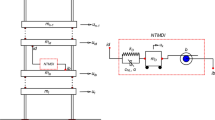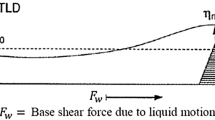Abstract
The effectiveness of a tuned mass damper (TMD) in dynamic vibration mitigation of a 20-storey steel benchmark structure (SBB) under real earthquake ground motions is presented. To study the positioning and tuning effect, a TMD is positioned at the largest or relatively larger of the normalized amplitude of mode shape of the selected structure. At each location, a TMD is tuned with different modal frequencies, while mitigating first five modal responses. The response of the SBB equipped with a TMD is obtained by numerically solving the differential equations of motion under different earthquakes, and subsequently compared with the corresponding uncontrolled building (NC), in order to investigate the efficiency of a TMD in seismic response control of buildings. Parameters considered for this study to be varied are (1) placement, (2) tuning frequency, and (3) mass ratio. The changes in the performance criteria (response) under various seismic excitations are calculated to evaluate the effectiveness of a TMD tuned to various modal frequencies, which are placed at different locations. It is noticed that the TMD tuned to the fundamental modal frequency and placed at the topmost floor leads to the best performance under earthquakes. It is also observed that controlling the higher modal response by a TMD will be efficient to substantially mitigate the seismic response of the SBB.










Similar content being viewed by others
References
Aly, A. M. (2014). Proposed robust tuned mass damper for response mitigation in buildings exposed to multidirectional wind. The Structural Design of Tall and Special Buildings,23(9), 664–691.
Bedon, C., & Amadio, C. (2017). Enhancement of the seismic performance of multi-storey buildings by means of dissipative glazing curtain walls. Engineering Structures,152, 320–334.
Bhaiya, V., Bharti, S. D., Shrimali, M. K., & Datta, T. K. (2019). Hybrid seismic control of buildings using tuned mass and magnetorheological dampers. In Proceedings of the institution of civil engineers - structures and buildings. https://doi.org/10.1680/jstbu.18.00090.
Bhandari, M., Bharti, S. D., Shrimali, M. K., & Datta, T. K. (2018). Assessment of proposed lateral load patterns in pushover analysis for base-isolated frames. Engineering Structures,175, 531–548.
Bhandari, M., Bharti, S., Shrimali, M. K., & Datta, T. K. (2019). Seismic fragility analysis of base-isolated building frame excited by near and far field earthquakes. Journal of Performance of Constructed Facilities (ASCE),33(3), 1–16.
Cao, L., & Li, C. (2019). Tuned tandem mass dampers–inerters with broadband high effectiveness for structures under white noise base excitations. Structural Control and Health Monitoring. https://doi.org/10.1002/stc.2319.
Chen, Y.-H., & Huang, Y.-H. (2004). Timoshenko beam with tuned mass dampers and its design curves. Journal of Sound and Vibration,278(4–5), 873–888.
Elias, S. (2018). Seismic energy assessment of buildings with tuned vibration absorbers. Shock and Vibration, 2018, 1–10.
Elias, S., & Matsagar, V. (2015). Optimum tuned mass damper for wind and earthquake response control of high-rise building. In V. Matsagar (Ed.), Advances in structural engineering (Vol. 2, pp. 1475–1487). India: Springer. (ISBN: 978-8-13-222192-0 (Print), 978-8-13-222193-7 (Online))
Elias, S., & Matsagar, V. (2017). Research developments in vibration control of structures using passive tuned mass dampers. Annual Reviews in Control,44, 129–156. https://doi.org/10.1016/j.arcontrol.2017.09.015.
Elias, S., & Matsagar, V. (2018a). Wind response control of tall buildings with a tuned mass damper. Journal of Building Engineering,15, 51–60. https://doi.org/10.1016/j.jobe.2017.11.005.
Elias, S., & Matsagar, V. (2018b). Wind response control of tall buildings with flexible foundation using tuned mass dampers. In Wind Engineering in Natural Hazards: Modeling, simulation, and mitigation of windstorm impact on critical infrastructure, Fluid Dynamics Committee, Special Issue by Engineering Mechanics Institute (EMI), American Society of Civil Engineers (ASCE), pp. 55–78. https://doi.org/10.1061/9780784415153.ch03
Elias, S., & Matsagar, V. (2019). Seismic vulnerability of non-linear building with distributed multiple tuned vibration absorbers. Structure and Infrastructure Engineering,15(8), 1103–1118.
Elias, S., Matsagar, V., & Datta, T. K. (2017). Distributed tuned mass dampers for multi-mode control of benchmark building under seismic excitations. Journal of Earthquake Engineering,23(7), 1137–1172.
Elias, S., Matsagar, V., & Datta, T. K. (2019). Dynamic response control of a wind-excited tall building with distributed multiple tuned mass dampers. International Journal of Structural Stability and Dynamics,19(06), 1950059.
Hadi, M. N. S., & Arfiadi, Y. (1998). Optimum design of absorber for MDOF structures. Journal of Structural Engineering, ASCE,124(11), 1272–1280.
Lu, Z., Li, K., & Zhou, Y. (2018). Comparative studies on structures with a tuned mass damper and a particle damper. Journal of Aerospace Engineering,31(6), 04018090.
Moutinho, C. (2012). An alternative methodology for designing tuned mass dampers to reduce seismic vibrations in building structures. Earthquake Engineering and Structural Dynamics,41(14), 2059–2079.
Spencer, B. F. Jr, Christenson, R. E., & Dyke, S. J. (1999). Next generation benchmark control problem for seismically excited buildings. In Proceedings of the second world conference on structural control, Kyoto, Japan, 29 June–2 July (pp. 1351–1360).
Tsai, H. C., & Lin, G. C. (1993). Optimum tuned mass dampers for minimizing steady state response of support excited and damped system. Earthquake Engineering and Structural Dynamics,22(11), 957–973.
Tsai, H. C., & Lin, G. C. (1994). Explicit formula for optimum absorber parameters for force excited and viscously damped systems. Journal of Sound and Vibration,176(5), 585–596.
Tuan, A. Y., & Shang, G. Q. (2014). Vibration control in a 101-storey building using a tuned mass damper. Journal of Applied Science and Engineering,17(2), 141–156.
Author information
Authors and Affiliations
Corresponding author
Ethics declarations
Conflict of interest
On behalf of all authors, the corresponding author states that there is no conflict of interest.
Additional information
Publisher's Note
Springer Nature remains neutral with regard to jurisdictional claims in published maps and institutional affiliations.
Rights and permissions
About this article
Cite this article
Elias, S., Matsagar, V. Seismic response control of steel benchmark building with a tuned mass damper. Asian J Civ Eng 21, 267–280 (2020). https://doi.org/10.1007/s42107-019-00206-1
Received:
Accepted:
Published:
Issue Date:
DOI: https://doi.org/10.1007/s42107-019-00206-1




